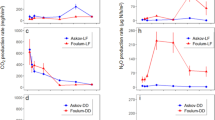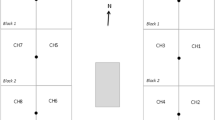Abstract
Soil carbon (C) content, often found at elevated levels in manured soils, can play a critical role in regulating nitrous oxide emissions. Nitrate availability and oxygen status are the other primary drivers of emissions, yet the interaction of these three variables and the dynamics of the denitrification process are inadequately known. Emissions of N2O and N2 were measured from two New York State soils that were historically managed either with regular cattle manure applications (M) or without manure (NM). For 168 h, repacked soil cores were maintained at 80 % water-filled pore space after the application of 0, 50, 100, and 200 kg ha−1 of labeled K15NO3. Significant differences were found in the N2O emission profiles between the two treatments with a simultaneous increasing trend in emissions with higher fertilizer applications. The M soil produced 53-, 15.5-, and 8.6-fold increases in N2O emissions over the NM soil at the 50-, 100-, and 200-kg ha−1 N rates, respectively. Additionally, the mean ratio of nitrous oxide to total denitrification (N2O/(N2O + N2)) was higher for M soil. It increased to values of 0.17, 0.25, and 0.43 for fertilizer rates of 50, 100, and 200 kg ha−1, respectively, in contrast to ratios in the NM soil of 0.01, 0.03, and 0.14.



Similar content being viewed by others
References
Arah JRM (1997) Apportioning nitrous oxide fluxes between nitrification and denitrification using gas-phase mass spectrometry. Soil Biol Biochem 29:1295–1299
Bateman EJ, Baggs EM (2005) Contributions of nitrification and denitrification to N2O emissions from soils at different water-filled pore space. Biol Fertil Soils 41:379–388
Bhogal A, Nicholson FA, Young I, Sturrock C, Whitmore A, Chambers BJ (2011) Effects of recent and accumulated livestock manure C additions on soil fertility and quality. Eur J Soil Sci 62:174–181
Blackmer AM, Bremner JM (1978) Inhibitory effect of nitrate on reduction of N2O to N2 by soil microorganisms. Soil Biol Biochem 10:187–191
Boyer JN, Groffman PM (1996) Bioavailability of water extractable organic carbon fractions in forest and agricultural soil profiles. Soil Biol Biochem 28:783–790
Burford JR, Bremner JM (1975) Relationships between the denitrification capacities of soils and total, water-soluble and readily decomposable soil organic matter. Soil Biol Biochem 7:389–394
Cavigelli MA, Robertson GP (2000) The functional significance of denitrifier community composition in a terrestrial ecosystem. Ecology 81:1402–1414
Cavigelli MA, Robertson GP (2001) Role of denitrifier diversity in rates of nitrous oxide consumption in a terrestrial ecosystem. Soil Biol Biochem 33:297–310
Crutzen PJ (1979) The role of NO and NO2 in the chemistry of the troposphere and stratosphere. Ann Rev Earth Planet Sci 7:443–472
Culman SW, Snapp SS, Shipanski ME et al (2012) Permanganate oxidizable carbon reflects a processed soil fraction that is sensitive to management. Soil Sci Soc Am J 76:494–504
Davidson EA (1991) Fluxes of nitrous oxide and nitric oxide from terrestrial ecosystems. In: Rogers JE, Whitman WB (eds) Microbial production and consumption of greenhouse gases: methane, nitrogen oxides, and halomethanes. American Society of Microbiology, Washington, pp 219–235
Dobbie KE, McTaggart IP, Smith KA (1999) Nitrous oxide emissions from intensive agricultural systems: variations between crops and seasons, key driving variables, and mean emission factors. J Geophys Res 104:26,891–26,899
EPA (2012) Inventory of U.S. greenhouse gas emissions and sinks: 1990–2010. U.S. Environmental Protection Agency, Office of Atmospheric Programs, Washington
Gentile R, Vanlauwe B, Chivenge P, Six J (2008) Interactive effects from combining fertilizer and organic residue inputs on nitrogen transformations. Soil Biol Biochem 40:2375–2384
Gillam KM, Zebarth BJ, Burton DL (2008) Nitrous oxide emissions from dentrification and the partitioning of gaseous losses as affected by nitrate and carbon addition and soil aeration. Can J Soil Sci 88:133–143
Guo X, Drury CF, Yang X, Reynolds WD, Zhang R (2011) Influence of current and previous crops on soil basal and potential denitrification rates. Biol Fertil Soils 47:937–947
Hoben JP, Gehl RJ, Millar N, Grace PR, Robertson GP (2011) Nonlinear nitrous oxide response to nitrogen fertilizer in on-farm corn crops of the US Midwest. Glob Chang Biol 17:1140–1152
IPCC (2007) Climate change 2007: the physical science basis. In: Qin D, Manning M, Chen Z, Marquis M, Averyt KB, Tignor M, Miller HL, Solomon S (eds) Contribution of Working Group to the Fourth Assessment Report of the Intergovernmental Panel on Climate Change. Cambridge University Press, Cambridge
Jager N, Stange CF, Ludwig B, Flessa H (2011) Emission rates of N2O and CO2 from soils with different organic matter content from three long-term fertilization experiments—a laboratory study. Biol Fertil Soils 47:483–494
Ma BL, Wu TY, Tremblay N et al (2010) Nitrous oxide fluxes from cornfields: on-farm assessment of the amount and timing of nitrogen fertilizer. Glob Chang Biol 16:156–170
McSwiney CP, Robertson GP (2005) Nonlinear response of N2O flux to incremental fertilizer addition in a continuous maize (Zea mays L.) cropping system. Glob Chang Biol 11:1712–1719
Millar N, Baggs EM (2004) Chemical composition, or quality, of agroforestry residues influences N2O emissions after their addition to soil. Soil Biol Biochem 36:935–943
Mulvaney RL (1984) Determination of N-15-labeled dinitrogen and nitrous-oxide with triple-collector mass spectrometers. Soil Sci Soc Am J 48:690–692
Panek JA, Matson PA, Ortiz-Monasterio I, Brooks P (2000) Distinguishing nitrification and denitrification sources of N2O in a Mexican wheat system using 15N. Ecol Appl 10:506–514
Parham JA, Deng SP, Da HN Sun HY, Raun WR (2003) Long-term cattle manure application in soil. II. Effect on soil microbial populations and community structure. Biol Fertil Soils 38:209–215
Parkin TB (1987) Soil microsites as a source of denitrification variability. Soil Sci Soc Am J 51:1194–1199
Paul JW, Beauchamp EG (1989) Effect of carbon constituents in manure on denitrification in soil. Can J Soil Sci 69:49–61
Potter C, Matson P, Davidson EA (1996) Process modeling of controls on nitrogen trace gas emissions from soils worldwide. J Geophys Res 101:1361–1377
Ravishankara AR, Daniel JS, Portmann RW (2009) Nitrous oxide (N2O): the dominant ozone-depleting substance emitted in the 21st Century. Science 326:123–125
Richardson D, Felgate H, Watmough N, Thomson A, Baggs E (2009) Mitigating release of the potent greenhouse gas N2O from the nitrogen cycle—could enzymic regulation hold the key? Trends Biotechnol 27:388–397
Rover M, Heinemeyer O, Munch JC, Kaiser EA (1999) Spatial heterogeneity within the plough layer: high variability of N2O emission rates. Soil Biol Biochem 31:167–173
Russow, Spott O, Stange CF (2008) Evaluation of nitrate and ammonium as sources of NO and N2O emissions from black earth soils (Haplic Chernozem) based on 15N field experiments. Soil Biol Biochem 40:380–391
Stevens RJ, Laughlin RJ (2002) Cattle slurry applied before fertilizer nitrate lowers nitrous oxide and dinitrogen emissions. Soil Sci Soc Am J 66:647–652
Stevens RJ, Laughlin RJ, Malone JP (1998) Measuring the mole fraction and source of nitrous oxide in the field. Soil Biol Biochem 30:541–543
Tiedje JM (1988) Ecology of denitrification and dissimilatory nitrate reduction to ammonium. In: Zehnder AJB (ed) Environmental microbiology of anaerobes. Wiley, New York, pp 179–244
USDA (2011) U.S. Agriculture and Forestry greenhouse gas inventory: 1990–2008. In: Del Grosso SJ, Eve MD (eds) Technical bulletin 1930. Office of the Chief Economist, U.S. Department of Agriculture, Washington
van Groenigen JW, Velthof GL, Oenema O, van Groenigen KJ, van Kessel C (2010) Towards an agronomic assessment of N2O emissions: a case study for arable crops. Eur J Soil Sci 61:903–913
Weier KL, Doran JW, Power JF, Walters DT (1993) Denitrification and the dinitrogen/nitrous oxide ratio as affected by soil water, available carbon and nitrate. Soil Sci Soc Am J 57:66–72
Weil RR, Islam KR, Stine MA, Gruver JB, Samson-Liebig SE (2003) Estimating active carbon for soil quality assessment: a simplified method for laboratory and field use. Am J Altern Agric 18:3–17
Zebarth BJ, Rochette P, Burton DL (2008) N2O emissions from spring barley production as influenced by fertilizer nitrogen rate. Can J Soil Sci 88:197–205
Acknowledgments
This research was supported through a grant from the USDA Northeast Region Sustainable Agriculture Research and Education program.
Author information
Authors and Affiliations
Corresponding author
Rights and permissions
About this article
Cite this article
Graham, C.J., van Es, H.M. & Melkonian, J.J. Nitrous oxide emissions are greater in silt loam soils with a legacy of manure application than without. Biol Fertil Soils 49, 1123–1129 (2013). https://doi.org/10.1007/s00374-013-0809-3
Received:
Revised:
Accepted:
Published:
Issue Date:
DOI: https://doi.org/10.1007/s00374-013-0809-3




